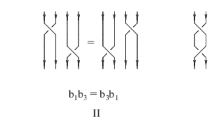Abstract
We introduce a knot semigroup as a cancellative semigroup whose defining relations are produced from crossings on a knot diagram in a way similar to the Wirtinger presentation of the knot group; to be more precise, a knot semigroup as we define it is closely related to such tools of knot theory as the twofold branched cyclic cover space of a knot and the involutory quandle of a knot. We describe knot semigroups of several standard classes of knot diagrams, including torus knots and torus links T(2, n) and twist knots. The description includes a solution of the word problem. To produce this description, we introduce alternating sum semigroups as certain naturally defined factor semigroups of free semigroups over cyclic groups. We formulate several conjectures for future research.


Similar content being viewed by others
Notes
Note that a knot semigroup is not a knot invariant; that is, there are cases when two different diagrams of the same knot produce non-isomorphic knot semigroups. See more in Sect. 8.
The property of being thin relative to knot semigroups can be reformulated as follows: if two words \(u=au'\) and \(v=bv'\) are equal, where a, b are letters, then there are letters c, d such that \(ac=bd\) and \(u=acu''\) and \(v=bdv''\).
It is known, see, for example, [15], that a presentation of a cancellative semigroup can be considerably more complicated than its cancellative presentation.
Reidemeister moves are standard ways of transforming a knot diagram to produce other diagrams of the same knot.
Note that the term ‘braid semigroup’ already has a well established meaning, namely, it is the subsemigroup of the braid group generated by clockwise half-twists (see, for example, [2]). To avoid confusion, we do not use the words ‘braid semigroup’ to mean the knot semigroup of a braid.
A meridian is an element of the knot group corresponding to one arc.
References
Diekert, V., Rozenberg, G.: The Book of Traces. World Scientific, Singapore (1995)
Bokut, L.A., Fong, Y., Ke, W.F., Shiao, L.S.: Gröbner-Shirshov bases for the braid semigroup. Adv. Algebra 10, (2003)
Cain, A.J., Gray, R., Malheiro, A.: On finite complete rewriting systems, finite derivation type, and automaticity for homogeneous monoids. submitted
Kudryavtseva, G., Mazorchuk, V.: On three approaches to conjugacy in semigroups. In Semigroup Forum, vol. 78, no. 1 (Springer, Berlin, 2009), pp. 14–20
Araújo, J., Konieczny, J., Malheiro, A.: Conjugation in semigroups. J. Algebra 403, 93–134 (2014)
Dehornoy, P.: Thin groups of fractions. Contemp Math 296, 95–128 (2002)
Picantin, M.: Garside monoids vs divisibility monoids. Math Struct in Comput Sci 15(02), 231–242 (2005)
Lickorish, W.R.: An Introduction to Knot Theory, vol. 175. Springer, Boston (2012)
Livingston, C.: Knot Theory, vol. 24. Cambridge University Press, Cambridge (1993)
Burde, G., Heusener, M., Zieschang, H.: Knots. De Gruyter, Berlin (2013)
Manturov, V.: Knot Theory. CRC Press, Boca Raton (2004)
Gilbert, N., Porter, T.: Knots and Surfaces. Oxford University Press, Oxford (1994)
Murasugi, K.: Knot Theory and its Applications. Springer, Boston (2007)
Howie, J., Short, H.: The band-sum problem. J Lond Math Soc 2(3), 571–576 (1985)
Spehner, J.: Présentations et présentations simplifiables d’un monoïde simplifiable. Semigroup Forum 14(1), 295–329 (1977)
Kawauchi, A.: A Survey of Knot Theory. Birkhäuser, Boston (1996)
Morgan, J.W., Bass, H.: The Smith Conjecture. Elsevier, Orlando (1984)
Winker, S.K.: Quandles, knot invariants, and the n-fold branched cover. Ph.D. dissertation, University of Illinois at Chicago (1984)
Fenn, R., Rourke, C.: Racks and links in codimension two. J Knot Theory Ramif 1(04), 343–406 (1992)
Joyce, D.: A classifying invariant of knots, the knot quandle. J Pure Appl Algebra 23(1), 37–65 (1982)
Harary, F., Kauffman, L.H.: Knots and graphs i – arc graphs and colorings. Adv Appl Math 22(3), 312–337 (1999)
Manturov, V., Ilyutko, D.: Virtual Knots: The State of the Art. World Scientific, Hackensack (2012)
Kauffman, L.H., Lambropoulou, S.: On the classification of rational tangles. Adv Appl Math 33(2), 199–237 (2004)
Conway, J.H.: An enumeration of knots and links, and some of their algebraic properties. In: Computational problems in abstract algebra (Proc. Conf., Oxford, 1967), 1970, pp. 329–358
Dynnikov, I.A.: Three-page approach to knot theory. Universal semigroup. Funct Anal Appl 34(1), 24–32 (2000)
Auinger, K., Chen, Y., Hu, X., Luo, Y., Volkov, M.: The finite basis problem for Kauffman monoids. Algebra universalis 74(3–4), 333–350 (2015)
Kassel, C., Turaev, V.: Braid groups. Springer, Boston (2008)
Author information
Authors and Affiliations
Corresponding author
Additional information
Communicated by Victoria Gould.
Rights and permissions
About this article
Cite this article
Vernitski, A. Describing semigroups with defining relations of the form \(xy=yz\) and \(yx=zy\) and connections with knot theory. Semigroup Forum 95, 66–82 (2017). https://doi.org/10.1007/s00233-016-9808-7
Received:
Accepted:
Published:
Issue Date:
DOI: https://doi.org/10.1007/s00233-016-9808-7




